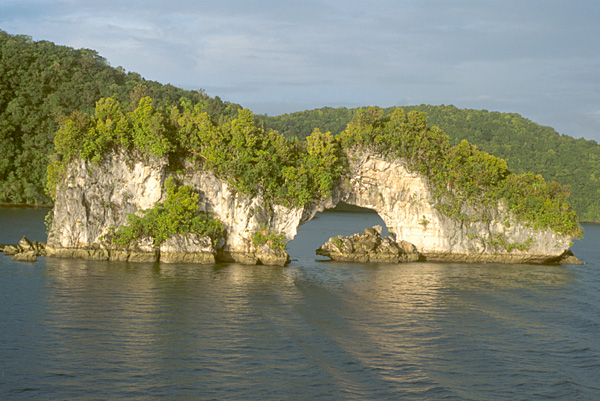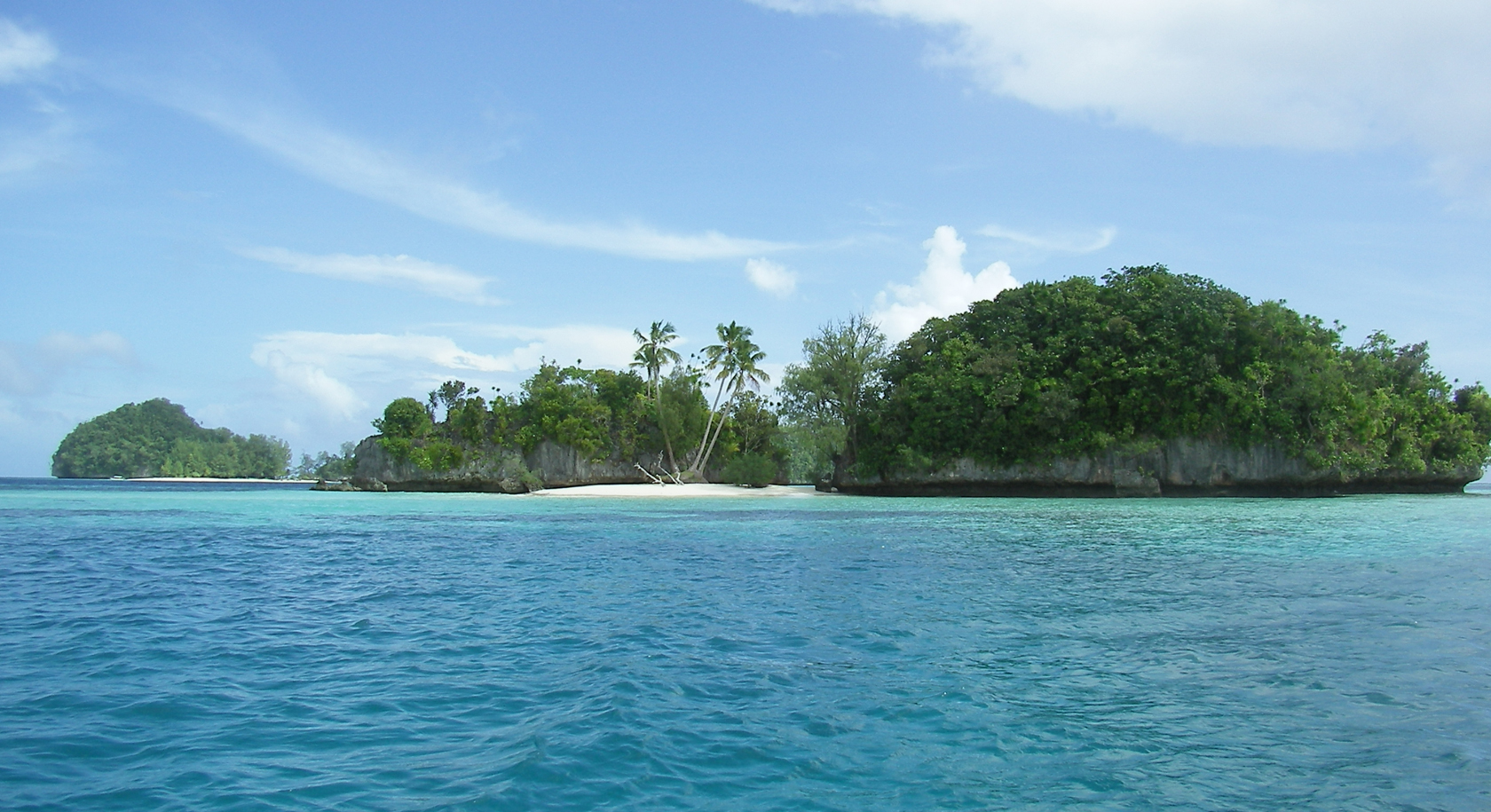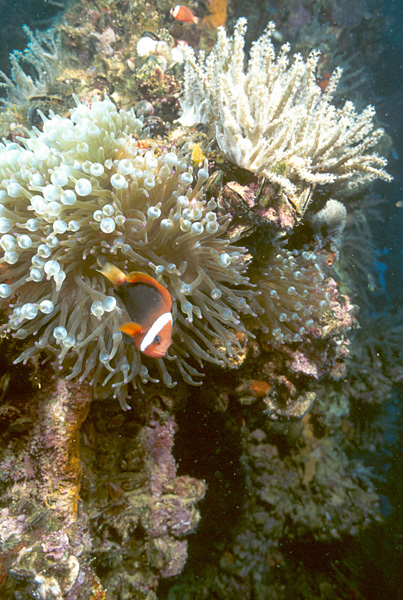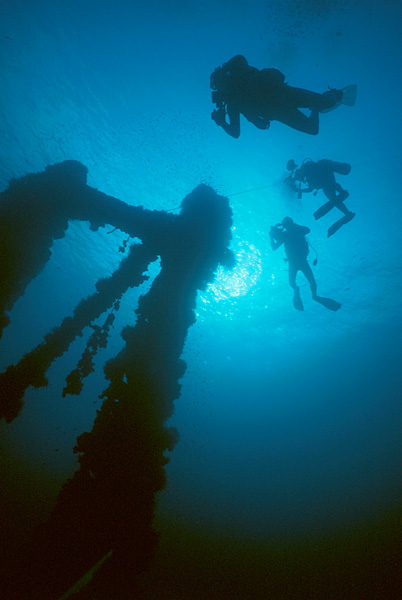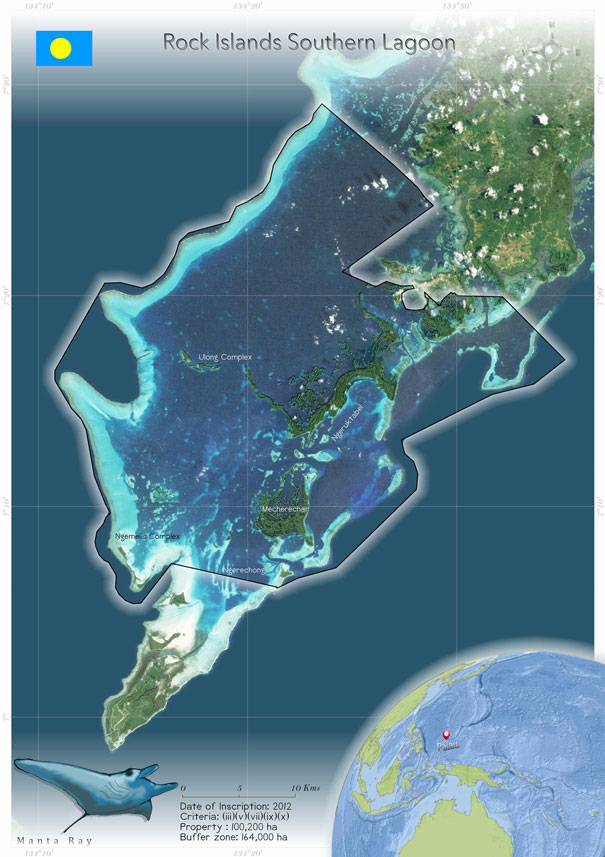
Rock Islands Southern Lagoon (1386)
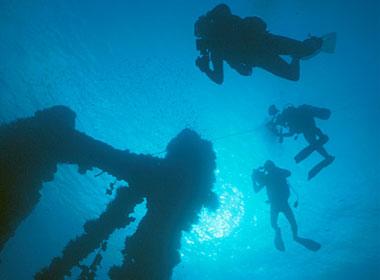 Rock Islands Southern Lagoon (RISL) was inscribed as a World Heritage Site in 2012 under the "Mixed" category. It spreads over 100,200 ha and includes 445 uninhabited limestone islands of volcanic origin in the western Pacific Ocean. Many of them display unique mushroom-like shapes in turquoise lagoons surrounded by coral reefs. The beauty of the site is heightened by a complex reef system featuring over 385 coral species and different types of habitat. The site has 52 enclosed marine lakes, representing one-fourth of the world's total. They were formed between 6000 and 15,000 years ago by rising sea levels and are nearly but not quite cut off from the sea. The site is home to remarkable numbers of endemic plants, birds, fishes and corals. These uninhabited islands were once home to Palauan settlements, but the people migrated later. Palauans continue to use the area and its resources for cultural and recreational purposes. The abandoned villages have the remains of defensive walls, terraces and house platforms. The current threats identified are increased tourism, habitat shifting/alteration, temperature extremes, invasive species and increasing ocean surface temperatures.
Rock Islands Southern Lagoon (RISL) was inscribed as a World Heritage Site in 2012 under the "Mixed" category. It spreads over 100,200 ha and includes 445 uninhabited limestone islands of volcanic origin in the western Pacific Ocean. Many of them display unique mushroom-like shapes in turquoise lagoons surrounded by coral reefs. The beauty of the site is heightened by a complex reef system featuring over 385 coral species and different types of habitat. The site has 52 enclosed marine lakes, representing one-fourth of the world's total. They were formed between 6000 and 15,000 years ago by rising sea levels and are nearly but not quite cut off from the sea. The site is home to remarkable numbers of endemic plants, birds, fishes and corals. These uninhabited islands were once home to Palauan settlements, but the people migrated later. Palauans continue to use the area and its resources for cultural and recreational purposes. The abandoned villages have the remains of defensive walls, terraces and house platforms. The current threats identified are increased tourism, habitat shifting/alteration, temperature extremes, invasive species and increasing ocean surface temperatures.
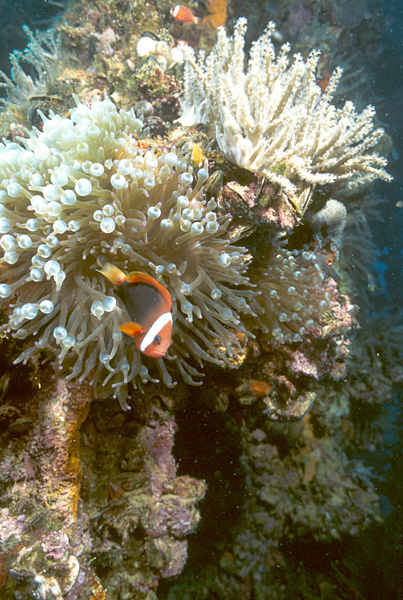 The property lies within (7° 14' N; 134° 21' E) Koror State, immediately to the south of Palau's main volcanic island, Babeldaob, in the western Pacific Ocean. The islands sustain a large diversity of endemic plants, birds and marine life, including the dugong and at least 13 shark species. The site has the highest concentration of marine lakes anywhere. These are isolated bodies of seawater separated from the ocean by land barriers. The terrestrial environment is harsh, supporting numerous endemic and endangered species, and the vegetation is lush. The climate of Palau can be classified as tropical maritime, being hot and humid, with the temperature remaining above 18°C throughout the year. It ranges between 26°C and 32°C, with the water temperature being a comfortable 28°C or 29°C round the year. There are two different seasons. The dry season is between December and April; the rainy season lasts from April to December (Bureau of Agriculture 2003). The annual rainfall is 3760 mm. There are heavier rains during the storm season, between July and October. The average relative humidity is 82%. The islands are affected by the oscillations of El Niño, and there are occasional storms (UNEP/WCMC 2012). The site comprises a maze of some 445 pristine, mostly small, well-forested raised coral islands, with fringing reefs and patch reefs within an enclosing barrier reef (UNESCO WHC 2012).
A total of 37 species of non-migratory wild bird, including 13 species endemic to Palau and five species endemic to Micronesia, were found by a recent survey in Rock Islands Southern Lagoon. Five migratory bird species and two non-migratory species of bat, were also found. Nine non-migratory bird species were found nesting, and the range of the endemic giant white-eye (Megazosterops palauensis) was found to have a larger range than previously known (Olsen et al. 2017).
The Rock Islands have 55 (42%) of Palau's 130 endemic plants (Kittalong et al. 2008). The islands are part of one of the most ecologically diverse ecosystems in the Indo-Pacific, with 32% of the region's coral reef fauna. This includes 746 of the over 1350 fish species of Palau, at least 13 of the 17 reported species of shark, seven species of giant clam, an estimated 385 species of stony coral in 66 genera, most of Palau's 150 species of soft coral and an endemic nautilus (UNEP/WCMC 2012, Claudino-Sales 2018). Although the islands are presently uninhabited, they were once home to Palauan settlements, and Palauans continue to use the area and its resources for cultural and recreational purposes. The use of resources is regulated through a traditional governance system that remains an important part of the national identity. The islands contain a significant set of cultural remains. Archaeological remains and rock art sites are found in two island clusters—Ulong and Negmelis—and on three islands—Ngeruktabel, Ngeanges and Chomedokl. Remains of former human occupants in caves, including rock art and burials, testify to seasonal human occupation and use of the marine ecosystem, dating back to 3100 BP and extending over a period of some 2500 years. The villages include the remains of defensive walls, terraces and house platforms. The descendants of the people who moved from Rock Islands to the main islands of Palau identify with their ancestral islands through oral traditions that record in legends, myths, dances and proverbs, and traditional place names the landscape and seascape of their former homes. The form and materials of village settlements and burial caves and their setting continue to convey the cultural value of the property.
The property lies within (7° 14' N; 134° 21' E) Koror State, immediately to the south of Palau's main volcanic island, Babeldaob, in the western Pacific Ocean. The islands sustain a large diversity of endemic plants, birds and marine life, including the dugong and at least 13 shark species. The site has the highest concentration of marine lakes anywhere. These are isolated bodies of seawater separated from the ocean by land barriers. The terrestrial environment is harsh, supporting numerous endemic and endangered species, and the vegetation is lush. The climate of Palau can be classified as tropical maritime, being hot and humid, with the temperature remaining above 18°C throughout the year. It ranges between 26°C and 32°C, with the water temperature being a comfortable 28°C or 29°C round the year. There are two different seasons. The dry season is between December and April; the rainy season lasts from April to December (Bureau of Agriculture 2003). The annual rainfall is 3760 mm. There are heavier rains during the storm season, between July and October. The average relative humidity is 82%. The islands are affected by the oscillations of El Niño, and there are occasional storms (UNEP/WCMC 2012). The site comprises a maze of some 445 pristine, mostly small, well-forested raised coral islands, with fringing reefs and patch reefs within an enclosing barrier reef (UNESCO WHC 2012).
A total of 37 species of non-migratory wild bird, including 13 species endemic to Palau and five species endemic to Micronesia, were found by a recent survey in Rock Islands Southern Lagoon. Five migratory bird species and two non-migratory species of bat, were also found. Nine non-migratory bird species were found nesting, and the range of the endemic giant white-eye (Megazosterops palauensis) was found to have a larger range than previously known (Olsen et al. 2017).
The Rock Islands have 55 (42%) of Palau's 130 endemic plants (Kittalong et al. 2008). The islands are part of one of the most ecologically diverse ecosystems in the Indo-Pacific, with 32% of the region's coral reef fauna. This includes 746 of the over 1350 fish species of Palau, at least 13 of the 17 reported species of shark, seven species of giant clam, an estimated 385 species of stony coral in 66 genera, most of Palau's 150 species of soft coral and an endemic nautilus (UNEP/WCMC 2012, Claudino-Sales 2018). Although the islands are presently uninhabited, they were once home to Palauan settlements, and Palauans continue to use the area and its resources for cultural and recreational purposes. The use of resources is regulated through a traditional governance system that remains an important part of the national identity. The islands contain a significant set of cultural remains. Archaeological remains and rock art sites are found in two island clusters—Ulong and Negmelis—and on three islands—Ngeruktabel, Ngeanges and Chomedokl. Remains of former human occupants in caves, including rock art and burials, testify to seasonal human occupation and use of the marine ecosystem, dating back to 3100 BP and extending over a period of some 2500 years. The villages include the remains of defensive walls, terraces and house platforms. The descendants of the people who moved from Rock Islands to the main islands of Palau identify with their ancestral islands through oral traditions that record in legends, myths, dances and proverbs, and traditional place names the landscape and seascape of their former homes. The form and materials of village settlements and burial caves and their setting continue to convey the cultural value of the property.
Criterion (iii)
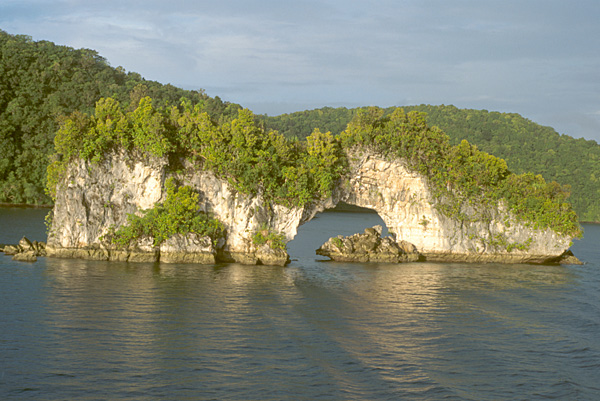 The Rock Islands cave deposits, burials, rock art, abandoned remains of stonework villages and middens bear exceptional testimony to the organisation of small island communities and their harvesting of marine resources over some three millennia.
The Rock Islands cave deposits, burials, rock art, abandoned remains of stonework villages and middens bear exceptional testimony to the organisation of small island communities and their harvesting of marine resources over some three millennia.
Criterion (v)
The Rock Islands cave deposits, burials, rock art, abandoned remains of stonework villages and middens bear exceptional testimony to the organisation of small island communities and their harvesting of marine resources over some three millennia.
Criterion (vii)
The Rock Islands Southern Lagoon contains an exceptional variety of habitats within a relatively limited area. Barrier and fringing reefs, channels, tunnels, caves, arches, and coves, as well as the highest number and density of marine lakes in the world, are home to diverse and abundant marine life. The maze of dome-shaped and green Rock Islands seemingly floating in the turquoise lagoon surrounded by coral reef is of exceptional aesthetic beauty.
Status
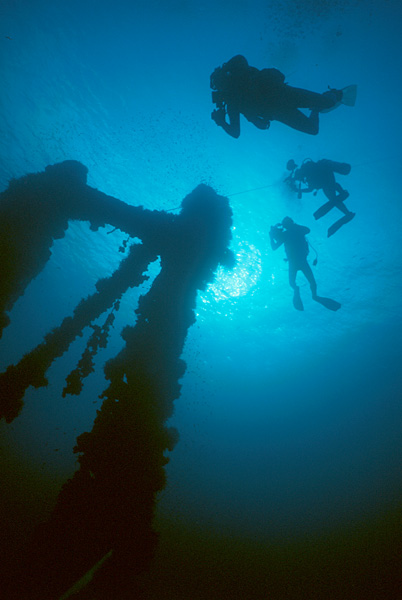 Palau, like many Pacific islands. is a popular travel destination among tourists, especially for underwater excursions. From 2010 to 2015, the total number of visitors to Palau nearly doubled. During 2015–2017, surveys were conducted at five popular snorkelling sites (visit sites) and five reference sites (non-visit sites) to quantify the fish density and biomass, the benthic cover and the number of visitors (boats and snorkellers). The volume of coral fragments at the non-visit sites were half of that at the visit sites. The benthic cover, including coral and rubble, was similar in visit and non-visit sites. The fish biomass was greater at visit sites (14 kg per 70 m3) compared with non-visit sites (8 kg per 70 m3). A study indicated that on average one out of five groups of snorkellers damaged live corals (Nestor et al. 2018).
Ngerukewid Islands Wildlife Preserve is Palau's oldest legislated protected area within RISL. In 2018, Palau International Coral Reef Center (PICRC) conducted a baseline ecological survey at 21 randomly selected sites within the two major marine habitats (lagoon and reef hole), collecting data on several ecological indicators. The coral coverage was low overall, less than 10% in both habitats. The coral cover of the lagoon was slightly higher (9.5%) coverage compared with the reef hole habitat, which had a mean coral coverage of 3.5%. Our results showing low coral-reef associated diversity are likely attributed to the distinctive natural environmental characteristics of Ngerukewid's Rock Islands system that is highly dominated by bottom sediments (Koshiba et al. 2019).
The endangered Micronesian scrubfowl (Megapodius laperouse senex), of Rock Island, was studied to understand its habitat use in the Rock Islands Southern Lagoon Conservation Area (RISL), of Palau, and the cumulative challenges the species faces because of tourist visits, invasive species and rising sea levels. Birds preferentially build mounds at the bases of large ironwood trees (Casuarina equisetifolia) but select sites with significantly more breadfruit trees (Artocarpus mariannensis). Scrubfowl forage in a non-preferential manner, making use of all littoral strand forest habitats. Direct anthropogenic habitat loss is not a major threat to scrubfowl in the RISL, but the breeding habitat is highly vulnerable to climate change-driven sea level rises (Radley et al. 2020).
Palau, like many Pacific islands. is a popular travel destination among tourists, especially for underwater excursions. From 2010 to 2015, the total number of visitors to Palau nearly doubled. During 2015–2017, surveys were conducted at five popular snorkelling sites (visit sites) and five reference sites (non-visit sites) to quantify the fish density and biomass, the benthic cover and the number of visitors (boats and snorkellers). The volume of coral fragments at the non-visit sites were half of that at the visit sites. The benthic cover, including coral and rubble, was similar in visit and non-visit sites. The fish biomass was greater at visit sites (14 kg per 70 m3) compared with non-visit sites (8 kg per 70 m3). A study indicated that on average one out of five groups of snorkellers damaged live corals (Nestor et al. 2018).
Ngerukewid Islands Wildlife Preserve is Palau's oldest legislated protected area within RISL. In 2018, Palau International Coral Reef Center (PICRC) conducted a baseline ecological survey at 21 randomly selected sites within the two major marine habitats (lagoon and reef hole), collecting data on several ecological indicators. The coral coverage was low overall, less than 10% in both habitats. The coral cover of the lagoon was slightly higher (9.5%) coverage compared with the reef hole habitat, which had a mean coral coverage of 3.5%. Our results showing low coral-reef associated diversity are likely attributed to the distinctive natural environmental characteristics of Ngerukewid's Rock Islands system that is highly dominated by bottom sediments (Koshiba et al. 2019).
The endangered Micronesian scrubfowl (Megapodius laperouse senex), of Rock Island, was studied to understand its habitat use in the Rock Islands Southern Lagoon Conservation Area (RISL), of Palau, and the cumulative challenges the species faces because of tourist visits, invasive species and rising sea levels. Birds preferentially build mounds at the bases of large ironwood trees (Casuarina equisetifolia) but select sites with significantly more breadfruit trees (Artocarpus mariannensis). Scrubfowl forage in a non-preferential manner, making use of all littoral strand forest habitats. Direct anthropogenic habitat loss is not a major threat to scrubfowl in the RISL, but the breeding habitat is highly vulnerable to climate change-driven sea level rises (Radley et al. 2020).
